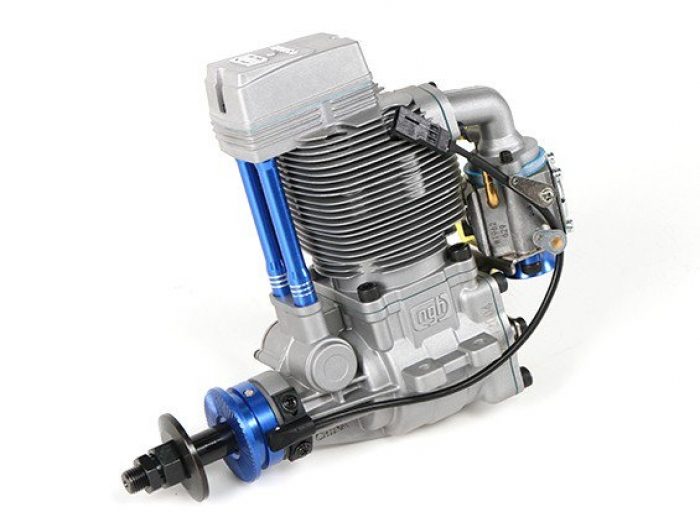
Two-stroke engine in a car
Content
The world of automobiles has seen a lot of powertrain developments. Some of them froze in time due to the fact that the designer did not have the means to further develop his brainchild. Others proved to be ineffective, so such developments did not have a promising future.
In addition to the classic in-line or V-shaped engine, manufacturers also produced cars with other designs of power units. Under the hood of some models one could see Wankel engine, boxer (or boxer), hydrogen motor. Some automakers can still use such exotic powertrains in their models. In addition to these modifications, history knows several more successful non-standard motors (some of them are A separate article).
Now let's talk about such an engine, with which almost none of the motorists come across, if not to talk about the need to mow the grass with a lawn mower or cut a tree with a chainsaw. This is a two-stroke power unit. Basically, this type of internal combustion engine is used in motor vehicles, tanks, piston aircraft, etc., but extremely rarely in cars.
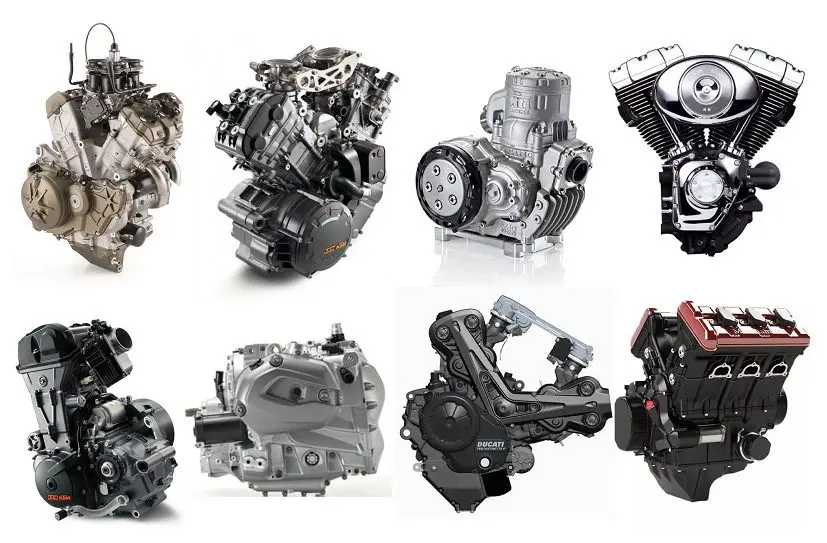
Also, two-stroke engines are very popular in motorsport, as these units have significant advantages. First, they have enormous power for a small displacement. Secondly, due to their simplified design, these motors are lightweight. These factors are very important for sports two-wheelers.
Consider the features of the device of such modifications, as well as whether it is possible to use them in cars.
What is a two-stroke engine?
For the first time, a patent for the creation of a two-stroke internal combustion engine appeared in the early 1880s. The development was presented by engineer Douglad Clerk. The device of his brainchild included two cylinders. One was a worker, and the other was pumping a fresh batch of military-technical cooperation.
10 years later, a modification with a chamber blowdown appeared, in which there was no longer a discharge piston. This motor was designed by Joseph Day.
In parallel with these developments, Karl Benz created his own gas unit, the patent for the production of which appeared in 1880.
The two-stroke dvigun, as its name implies, in one turn of the crankshaft performs all the strokes necessary for the supply and combustion of the air-fuel mixture, as well as for the removal of combustion products into the vehicle exhaust system. This ability is provided by a design feature of the unit.
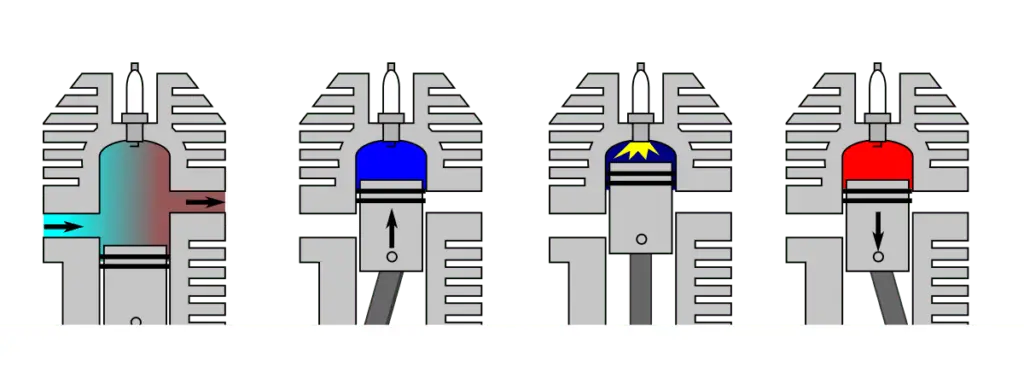
During one stroke of the piston, two strokes are performed in the cylinder:
- When the piston is at bottom dead center, the cylinder is purged, that is, combustion products are removed. This stroke is provided by the intake of a fresh portion of the VTS, which displaces the exhaust into the exhaust tract. At the same moment, the chamber is filled with a fresh portion of VTS.
- Rising to the top dead center, the piston closes the inlet and outlet, which ensures the compression of the BTC in the above-piston space (without this process, efficient combustion of the mixture and the required output of the power unit are impossible). At the same time, an additional portion of the mixture of air and fuel is sucked into the cavity under the piston. A spark is generated at the TDC of the piston, which ignites the air / fuel mixture. The working stroke begins.
This repeats the motor cycle. It turns out that in a two-stroke, all strokes are performed in two strokes of the piston: while it moves up and down.
The device of a two-stroke engine?
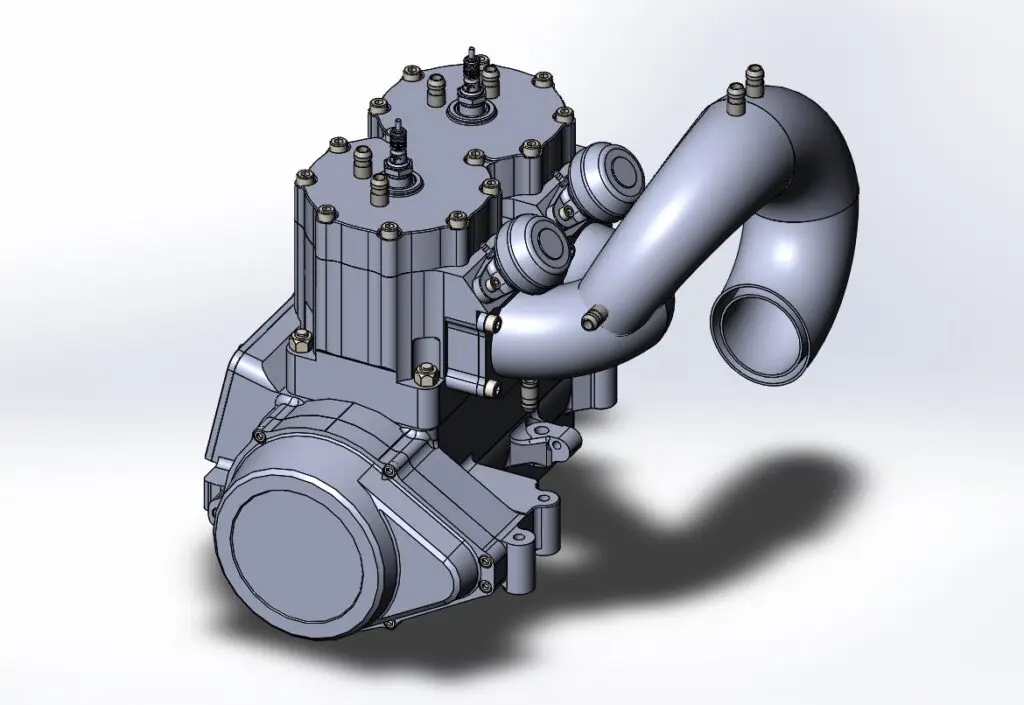
The classic two-stroke internal combustion engine consists of:
- Carter. This is the main part of the structure, in which the crankshaft is fixed with ball bearings. Depending on the size of the cylinder-piston group, there will be a corresponding number of cranks on the crankshaft.
- Piston. This is a piece in the form of a glass, which is fixed on the connecting rod, similar to the analog used in four-stroke engines. It has grooves for the compression rings. The efficiency of the unit during the combustion of the MTC depends on the density of the piston, as in other types of motors.
- Inlet and outlet. They are made in the internal combustion engine housing itself, where the intake and exhaust manifolds are connected. There is no gas distribution mechanism in such an engine, due to which the two-strokes are lightweight.
- Valve. This part prevents the air / fuel mixture from being thrown back into the intake tract of the unit. When the piston rises, a vacuum is created under it, moving the flap, through which a fresh portion of BTC enters the cavity. As soon as there is a stroke of the working stroke (a spark was triggered and the mixture ignited, moving the piston to the bottom dead center), this valve closes.
- Compression rings. These are the same parts as in any other internal combustion engine. Their dimensions are selected strictly according to the dimensions of a particular piston.
Hofbauer two-stroke design
Due to many engineering obstacles, the idea of using two-stroke modifications in light vehicles has not been possible until recently. In 2010, a breakthrough was made in this regard. EcoMotors has received a decent investment from Bill Gates and Khosla Ventures. The reason for such waste was the presentation of the original boxer engine.
Although such a modification has been around for a long time, Peter Hofbauer created the concept of a two-stroke that worked on the principle of a classic boxer. The company called its work OROS (translated as opposed cylinders and opposed pistons). Such a unit can work not only on gasoline, but also on diesel, but the developer has so far settled on solid fuel.
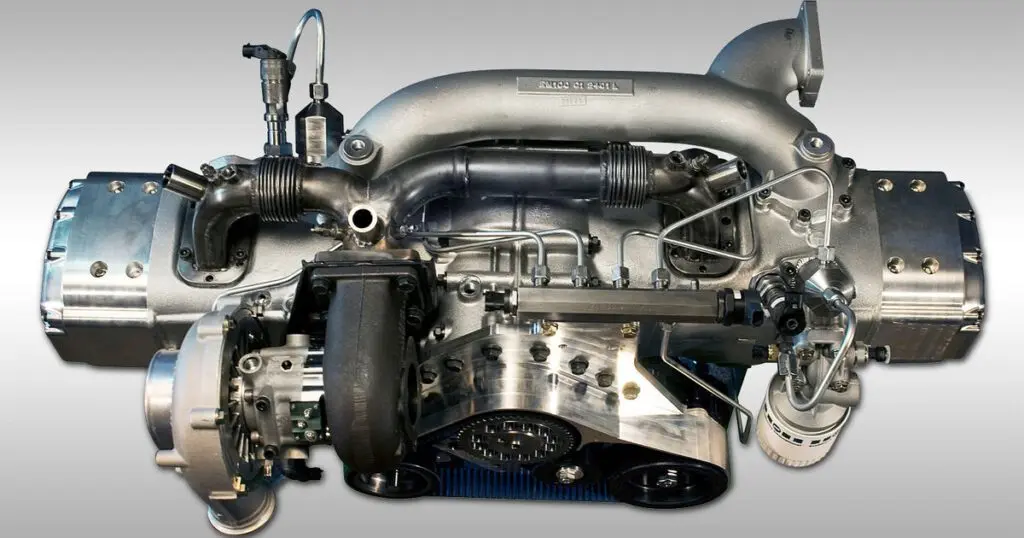
If we consider the classic design of a two-stroke in this capacity, then in theory it can be used in a similar modification and installed on a passenger 4-wheel vehicle. It would be possible if it were not for environmental standards and high cost of fuel. During operation of a conventional two-stroke internal combustion engine, part of the air-fuel mixture is removed through the exhaust port during the purging process. Also, in the process of combustion of BTC, oil is also burned.
Despite the great skepticism of engineers from leading automakers, the Hofbauer engine opened up the opportunity for two-strokes to get under the hood of luxury cars. If we compare its development with the classic boxer, then the new product is 30 percent lighter, since its design has fewer parts. The unit also demonstrates more efficient energy production during operation compared to a four-stroke boxer (efficiency increase within 15-50 percent).
The first working model received the EM100 marking. According to the developer, the weight of the motor is 134 kg. Its power is 325 hp, and the torque is 900 Nm.
The design feature of the new boxer is that two pistons are located in one cylinder. They are mounted on the same crankshaft. The combustion of the VTS occurs between them, due to which the released energy simultaneously acts on both pistons. This explains such a huge torque.
The opposite cylinder is configured to act asynchronously with the adjacent one. This ensures smooth crankshaft rotation without jerking with a stable torque.
In the following video, Peter Hofbauer himself demonstrates how his motor works:
Let's take a closer look at its internal structure and the general scheme of work.
Turbocharging
Turbocharging is provided by an impeller, on the shaft of which an electric motor is installed. Although it will run partly from the flow of exhaust gases, electronically charging the impeller allows the impeller to accelerate faster and generate air pressure. To compensate for the energy consumption of spinning the impeller, the device generates electricity when the blades are subjected to exhaust pressure. The electronics also control the flow of the exhaust to reduce environmental pollution.
This element in the innovative two-stroke is rather controversial. To quickly create the necessary air pressure, the electric motor will consume a decent amount of energy. To do this, a future car that will use this technology will have to be equipped with a more efficient generator and batteries with increased capacity.
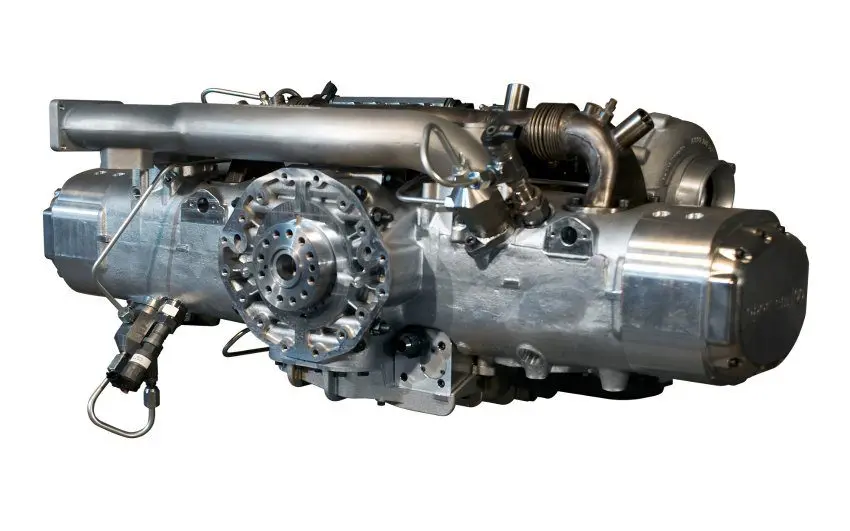

As of today, the efficiency of electric supercharging is still on paper. The manufacturer claims this system improves cylinder purge while maximizing the benefits of a two-stroke cycle. In theory, this installation allows you to double the liter capacity of the unit when compared with four-stroke counterparts.
The introduction of such equipment will definitely make the power plant more expensive, which is why it is still cheaper to use a powerful and gluttonous classic internal combustion engine than a new lightweight boxer.
Steel connecting rods
By its design, the unit resembles TDF engines. Only in this modification, the counter pistons set in motion not two crankshafts, but one due to the long connecting rods of the external pistons.
The outer pistons in the engine are mounted on long steel connecting rods that are connected to the crankshaft. It is located not at the edges, as in the classic boxer modification, which is used in military equipment, but between the cylinders.
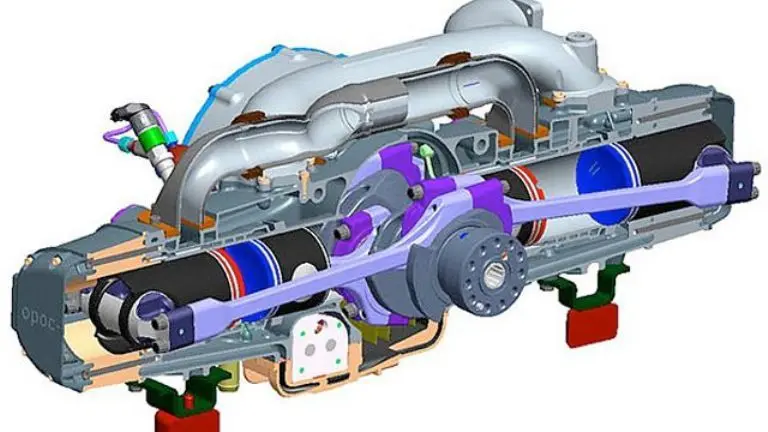

The internal elements are also connected to the crank mechanism. Such a device allows you to extract more energy from the combustion process of the air-fuel mixture. The motor behaves as if it has cranks that provide increased piston stroke, but the shaft is compact and lightweight.
Crankshaft
The Hofbauer motor is modular in design. The electronics are able to turn off some of the cylinders, so that the car can be more economical when the ICE is at a minimum load (for example, at cruising speed on a flat road).
In 4-stroke engines with direct injection (for details on the types of injection systems, read in another review) shutdown of the cylinders is ensured by stopping the fuel supply. In this case, the pistons still move in the cylinders due to the rotation of the crankshaft. They just do not burn fuel.
As for the innovative development of Hofbauer, the shutdown of a pair of cylinders is provided by a special clutch mounted on the crankshaft between the corresponding pairs of cylinder-piston. When the module is disconnected, the clutch simply disconnects the part of the crankshaft that is responsible for this section.
Since moving pistons in a classic 2-stroke internal combustion engine at idle speed will still suck in a fresh portion of VTS, in this modification this module stops working altogether (the pistons remain immobilized). As soon as the load on the power unit increases, at a certain moment, the clutch connects the inoperative section of the crankshaft, and the motor increases power.
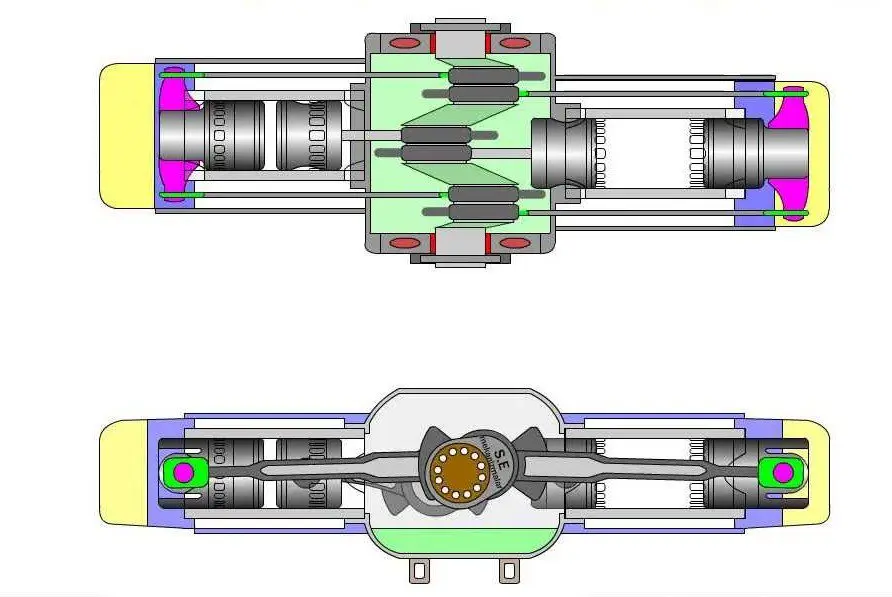

Cylinder
In the process of cylinder airing, classic 2-stroke valves emit part of the unburned mixture into the atmosphere. Because of this, vehicles equipped with such a power unit are not able to meet environmental standards.
To remedy this shortcoming, the developer of the two-stroke opposed engine has designed a special cylinder design. They also have inlets and outlets, but their location reduces emissions.
How a two-stroke internal combustion engine works
The peculiarity of the classic two-stroke modification is that the crankshaft and piston are in a cavity filled with an air-fuel mixture. An inlet valve is installed on the inlet. Its presence allows you to create pressure in the cavity under the piston when it begins to move downward. This head accelerates cylinder purging and exhaust gas removal.
As the piston moves inside the cylinder, it alternately opens / closes the inlet and outlet. For this reason, the design features of the unit make it possible not to use the gas distribution mechanism.
To prevent the rubbing elements from excessively wearing out, they need high-quality lubrication. Since these motors have a simple structure, they are deprived of a complex lubrication system that would deliver oil to every part of the internal combustion engine. For this reason, some engine oil is added to the fuel. For this, a special brand is used for two-stroke units. This material must retain lubricity at high temperatures, and when burned together with fuel, it must not leave carbon deposits.
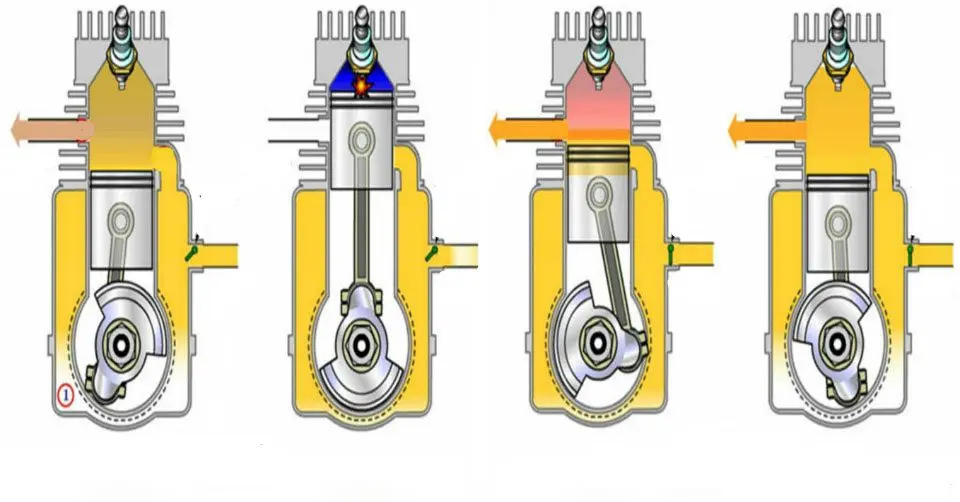

Although two-stroke engines were not widely used in cars, history knows periods when such engines were located under the hood of some trucks (!). An example of this is the YaAZ diesel power unit.
In 1947, an in-line 7-cylinder diesel engine of this design was installed on the 200-ton trucks YaAZ-205 and YaAZ-4. Despite the large weight (about 800 kg.), The unit had lower vibrations than many internal combustion engines of domestic passenger cars. The reason is that the device of this modification includes two shafts that rotate synchronously. This balancing mechanism dampened most of the vibrations in the engine, which would quickly crumble the wooden truck body.
More details about the operation of 2-stroke motors are described in the following video:


Watch this video on YouTube
Where is a two-stroke motor needed?
The device of a 2-stroke engine is simpler than a 4-stroke analogue, due to which they are used in those industries where weight and volume are more important than fuel consumption and other parameters.
So, these motors are installed on lightweight wheeled lawn mowers and hand trimmers for gardeners. Holding a heavy motor in your hands makes it very difficult to work in the garden. The same concept can be traced in the manufacture of chainsaws.
Its efficiency also depends on the weight of water and air transport, so manufacturers compromise on high fuel consumption in order to create lighter structures.
However, 2-tatniks are used not only in agricultural and some types of aircraft. In auto / moto sports, weight is just as important as in gliders or lawn mowers. In order for a car or motorcycle to develop high speed, designers, creating such vehicles, use lightweight materials. Details of the materials from which car bodies are made is described here... For this reason, these engines have an advantage over heavy and technically complex 4-stroke analogues.


Here is a small example of the effectiveness of a two-stroke modification of an internal combustion engine in sports. Since 1992, some motorcycles have used a Japanese Honda NSR4 500-cylinder V-twin engine in MottoGP motorcycle races. With a volume of 0.5 liters, this unit developed 200 horsepower, and the crankshaft spun up to 14 thousand revolutions per minute.
The torque is 106 Nm. reached already at 11.5 thousand. The peak speed that such a kid was able to develop was more than 320 kilometers per hour (depending on the weight of the rider). The weight of the engine itself was only 45kg. One kilogram of vehicle weight accounts for almost one and a half horsepower. Most sports cars will envy this power-to-weight ratio.
Comparison of two-stroke and four-stroke engine
The question is why, then, the machine cannot have such a productive unit? Firstly, the classic two-stroke is the most wasteful unit of all that is used in vehicles. The reason for this is the peculiarities of blowing and filling the cylinder. Secondly, as for racing modifications like the Honda NSR500, the operating life of the unit is very small due to the high revs.
The advantages of a 2-stroke unit over a 4-stroke analogue include:
- The ability to remove power from one revolution of the crankshaft is 1.7-XNUMX times higher than that produced by a classic engine with a gas distribution mechanism. This parameter is of greater importance for low-speed marine technology and piston aircraft models.
- Due to the design features of the internal combustion engine, it has smaller dimensions and weight. This parameter is very important for light vehicles such as scooters. Previously, such power units (usually their volume did not exceed 1.7 liters) were installed in small cars. In such modifications, crank-chamber blowing was provided. Some truck models were also equipped with two-stroke engines. Usually the volume of such internal combustion engines was at least 4.0 liters. The blowing in such modifications was carried out by the direct-flow type.
- Their parts wear out less, since the moving elements, to achieve the same effect as in 4-stroke analogs, perform twice as few movements (two strokes are combined in one piston stroke).
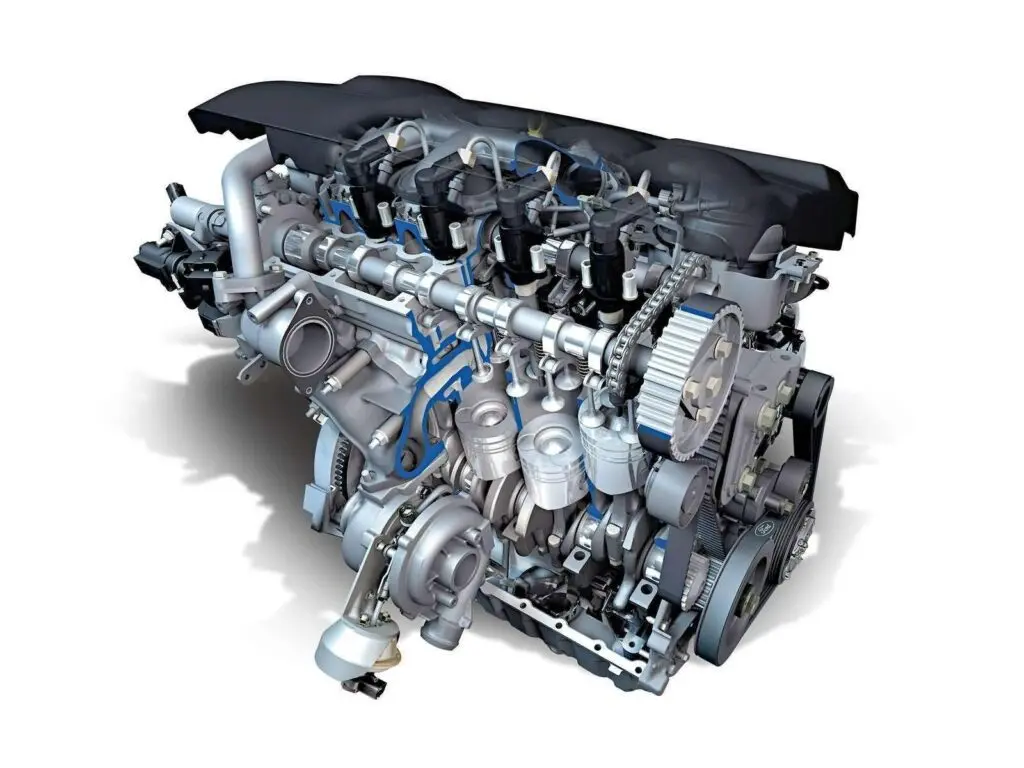

Despite these advantages, the two-stroke engine modification has significant drawbacks, because of which it is not yet practical to use it in cars. Some of these cons:
- Carburetor models operate with the loss of a fresh charge of the VTS during the purging of the cylinder chamber.
- In the 4-stroke version, the exhaust gases are removed to a greater extent than in the considered analogue. The reason is that in a 2-stroke, the piston does not reach top dead center during purging, and this process is ensured only during its small stroke. Because of this, some of the air-fuel mixture enters the exhaust tract, and more exhaust gases remain in the cylinder itself. To reduce the amount of unburned fuel in the exhaust, modern manufacturers have developed modifications with an injection system, but even in this case it is impossible to completely remove combustion residues from the cylinder.
- These motors are more power hungry compared to 4-stroke versions with identical displacement.
- High performance turbochargers are used to purge the cylinders in injection engines. In such motors, air is consumed one and a half to two times more. For this reason, special air filters are required.
- The 2-stroke unit generates more noise when reaching maximum rpm.
- They smoke harder.
- At low revs, they generate strong vibrations. There is no difference in single-cylinder engines with four and two strokes in this regard.
With regard to the durability of two-stroke engines, it is believed that due to poor lubrication they fail faster. But, if you do not take into account the units for sports motorcycles (high revs quickly disable parts), then a key rule works in mechanics: the simpler the design of the mechanism, the longer it will last.
4-stroke engines have a greater number of small parts, especially in the gas distribution mechanism (for how the valve timing works, read here), which can break at any time.
As you can see, the development of internal combustion engines has not stopped so far, so who knows what breakthrough in this area will be made by engineers. The emergence of a new development of the two-stroke engine gives hope that in the near future, cars will be equipped with lighter and more efficient powertrains.
In conclusion, we suggest looking at another modification of a two-stroke engine with pistons moving towards each other. True, this technology cannot be called innovative, like the Hofbauer version, because such internal combustion engines began to be used back in the 1930s in military equipment. However, for light vehicles, such 2-stroke engines have not yet been used:


Watch this video on YouTube
Questions and answers:
What does a 2-stroke engine mean? Unlike a 4-stroke engine, all strokes are performed in one revolution of the crankshaft (two strokes are performed in one piston stroke). In it, the process of filling the cylinder and ventilating it are combined.
How is a two-stroke engine lubricated? All rubbing internal surfaces of the engine are lubricated by the oil in the fuel. Therefore, the oil in such an engine must be constantly topped up.
How does a 2-stroke engine work? In this internal combustion engine, two strokes are clearly expressed: compression (the piston moves to TDC and gradually closes first the purge and then the exhaust port) and the working stroke (after the ignition of the BTC, the piston moves to the BDC, opening the same ports for purging).

One comment
Rant
RIP 2T Car makers: Saab, Trabant, Wartburg.
2T Car maker still exist(only restores 2T cars) : Melkus
Motorcycle Makers still making 2T motorcycles: Langen, Maico-Köstler, Vins.